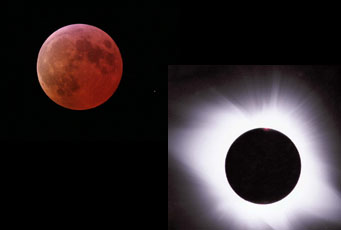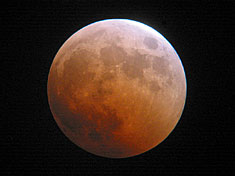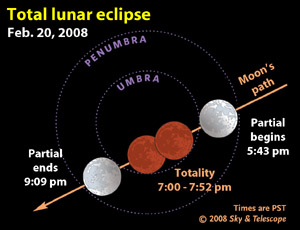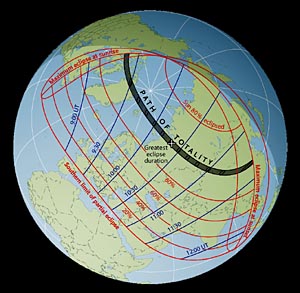
A total eclipse of the Moon (left) and one of the Sun (right) will occur in 2008.
S&T: Rick Fienberg (left) and Dennis di Cicco (right)
In August 2008, after a 28-month drought, Earth is touched by a total eclipse of the Sun, and eclipse-chasers everywhere are rejoicing at the prospect. Standing in the Moon's shadow is a never-to-be-forgotten experience, but seeing any eclipse is well worth the effort. In 2008, there are four.
Eclipses come in two styles — solar and lunar — and each has its variants. A solar eclipse occurs when the Moon passes directly between Earth and the Sun, something that can only happen at new Moon. If the lunar disk completely hides the Sun, even for a moment, the eclipse is total. Those who live within, or travel to, the narrow path of totality see the Sun's ruby-red gaseous prominences and ghostly white outer atmosphere momentarily revealed when the brilliant solar disk is fully covered. Outside the path, about half the world is able to watch a partial eclipse as the Moon obscures a portion of the Sun.
Occasionally the Moon passes directly in front of the Sun but doesn't completely cover it. This odd-sounding situation is an annular eclipse, so-called because at mid-eclipse a ring, or annulus, of sunlight surrounds the lunar disk. Outside the zone of annularity, observers see a partial solar eclipse.

Rick Fienberg snapped this 1-second exposure at the onset of totality in October 2004 using a Tele Vue-85 refractor, Canon PowerShot G2 digital camera, and 30-mm Plössl eyepiece. As totality ended about an hour later, so too did the Curse of the Bambino as the Red Sox won their first World Series since 1918!
A lunar eclipse takes place when Earth's shadow falls onto the Moon's surface. The type of eclipse (partial or total) depends on how deep the full Moon plunges into the umbra, our planet's dark, central shadow. If it goes all the way in, we see a total lunar eclipse that's preceded and followed by partial phases. If the Moon skims the umbra, only the partial phases occur.
Here is a brief description of this year's eclipses of the Sun and Moon. More details will appear on this website and in Sky & Telescope magazine as the date of each draws near. Times are in Universal Time (UT or GMT) except as noted. All the non-S&T diagrams found via the links are courtesy Fred Espenak
February 7: Annular Eclipse
The path of the first eclipse of 2008 traverses a frozen corner of Antarctica and the southern waters of the Pacific Ocean. While very few will see the two-minute-long annular phase, observers in New Zealand and southeastern Australia will be treated to a partial eclipse of the Sun during the afternoon of the 7th.

February 20th's total lunar eclipse will be a prime-time event for skywatchers in the US and Canada. Totality lasts 52 minutes, with mid-eclipse occurring at 7:26 p.m. PST. (To get times for your location, add 1 hours for Mountain time, 2 for Central, 3 for Eastern, and 4 for Atlantic.)
S&T: Gregg Dinderman
February 20–21: Total Lunar Eclipse
This event is the highlight of the year for those who can't get to the solar eclipse on August 1st. As this map shows, the entire lunar eclipse will be visible across Europe and western Africa on the morning of the 21st, and throughout North and South America on the evening of the 20th. Look for the full Moon to begin sliding into the umbra at 8:43 p.m. Eastern Standard Time (5:43 p.m. Pacific, 1:43 a.m. UT). Totality strikes at 10:00 p.m. Eastern and lasts for 52 minutes. The Moon exits Earth's umbra, ending the partial phase, just after midnight (12:09 a.m. Eastern). Click here for more details.
This is the third total lunar eclipse in less than a year, so if you've missed the other two, don't neglect this one. Several partials are upcoming, but the next total eclipse of the Moon won't take place until December 20–21, 2010.

The narrow ribbon of the Moon's shadow on August 1st takes a northerly route across sparesely inhabited regions. Universal times (black lines) are given for mid-eclipse; red lines show how much of the Sun will be covered by a partial eclipse. Click on the image for a larger view.
© Fred Espenak
August 1: Total Solar Eclipse
The narrow path of totality of the first total eclipse of the Sun since March 2006 will sweep across northern Canada and the Arctic, through central Russia, and into Mongolia, ending in China. At mid-eclipse near Nadym in northern Russia, observers will experience 2 minutes 27 seconds of totality. Outside the centerline track, the partial phases of the eclipse will be visible across all of Asia (excluding Japan), central and eastern Europe, and northern Canada. For more details, see page 34 of the January 2008 issue of Sky & Telescope.
August 16: Partial Lunar Eclipse
A partial eclipse of the Moon ends the 2008 eclipse season. The lunar disk will pass through the northern half of the Earth's umbral shadow, resulting in a partial phase that lasts 3 hours 9 minutes. This eclipse will be
visible in its entirety to skygazers in Africa, Europe, and central Asia. Those in eastern South America, South-East Asia, and Australia will see the partially eclipsed full Moon either rise or set.
It's been a while since North America experienced a total solar eclipse of the Sun. But take heart, not much longer to wait, because August 21, 2017 is the date. Here's a map showing future total solar eclipse paths over Canada, Mexico, and the United States through 2050.
 0
0
Comments
You must be logged in to post a comment.